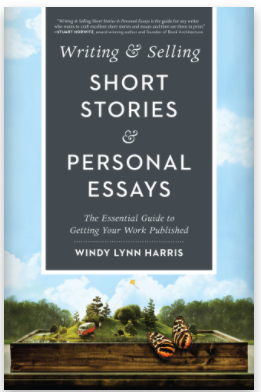
This post is by my guest Windy Lynn Harris, author of Writing & Selling Short Stories & Personal Essays: The Essential Guide To Getting Your Work Published (Writer’s Digest Books, 2017)

Writing a short story is a worthy mission. Short stories are fun to write, fast to compose (well, faster than books), and they get published every single day. Here’s a quick guide to help you craft short stories like a pro.
Before we get started, let’s put ourselves in short story mode. Your goal when writing a short story is to deliver a satisfying narrative in a very small package. Short stories aren’t tiny novels. They rarely have any subplots at all. Instead, the action revolves around one main conflict. The theme is revealed through a character and his or her obstacles. Tension keeps the reader invested in the stakes all the way through to the resonant ending.
That might sound like a lot to manage all at once, but if you break the artistic process down to three steps, you’ll find your way to a satisfying story without wandering off the map.
STEP ONE: APPROACH THE PAGE WITH CURIOSITY
To begin a short story, you don’t need to have much of your narrative figured out ahead of time. In fact, it’s best not to overthink a short story at all before you write it. Come to the page good and open. Be ready for anything. All you need is a “doorway” into your story.
A doorway is one of three things: A Character, a Plot, or a Theme. You might already have a character in mind, or an event, or a meaningful message, but if you don’t, that’s okay too. You can find a doorway by writing. A few minutes of free writing or personal journaling is enough to spark your brain into story mode. Once you’ve got a doorway, start writing that short story.
STEP TWO: ALLOW YOUR STORY TO EMERGE
To write a strong short story, you have to get out of the way and let your creative side run wild during the first draft. No self-editing allowed. Let yourself type every single sentence that comes to you. Even the ones that make you cringe. Don’t overthink it. Just move forward in the narrative. Acknowledge new doors along the way and follow where they lead.
STEP THREE: DIG FOR THE REAL STORY AMONG YOUR PROSE
Rather than judge your first draft as “good” or “bad,” consider the document as an idea-catcher. The key to creating a terrific short story is to discern the most appealing narrative from the words and ideas on your page. Look for story clues among the prose that will help you discover the best parts of your draft. Circle your exceptional sentences, your favorite story moments, and any images that feel original. Then ask yourself:
- What is this story really about? (THEME)
- Does the order of events make sense? (PLOT)
- Who is this person and what do they want? (CHARACTER)
- What is at stake? (CONFLICT)
- Does this story happen in the right place? (SETTING)
Revise your story based on the answers. It may take several drafts and lots of decision making to complete your work, but the effort is worth your time. Your determination will pay off in stories you’re proud of and publication opportunities in magazines.


Windy Lynn Harris helps others write from the heart, edit for publication, and submit their work with confidence. You can find out more at WindyLynnHarris.com and you can hear us talk (excitedly) about short fiction on the several episode of the StoryADay podcast.


